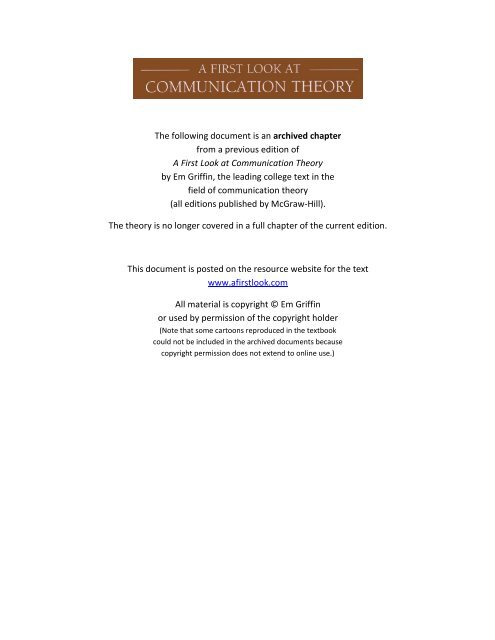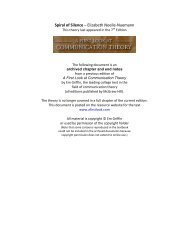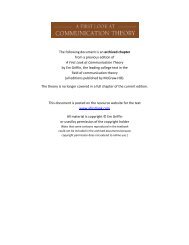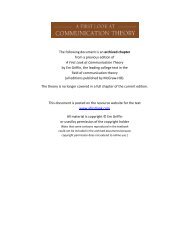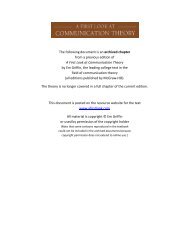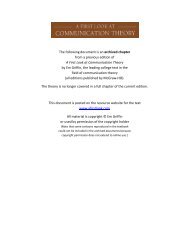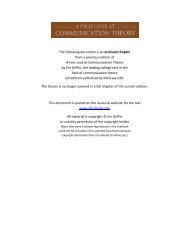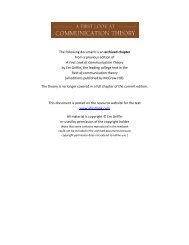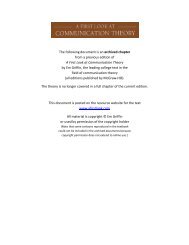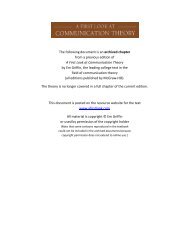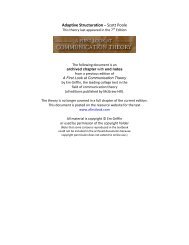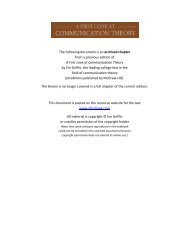Hierarchy of Needs (PDF) - A First Look at Communication Theory
Hierarchy of Needs (PDF) - A First Look at Communication Theory
Hierarchy of Needs (PDF) - A First Look at Communication Theory
Create successful ePaper yourself
Turn your PDF publications into a flip-book with our unique Google optimized e-Paper software.
126 ZNTRAPERSONAL COMMUNlCATlONesteem. Note the s<strong>of</strong>tening <strong>of</strong> terminology used to describe the move up theladder. We’re driven to s<strong>at</strong>isfy the lower needs, but we’re drawn to meet thehigher ones.Maslow referred to the four lower needs as “deficiency needs” becausetheir lack cre<strong>at</strong>es a tension within us. He saw nothing wrong with the humandesire to scr<strong>at</strong>ch where we itch. As long as we can work to s<strong>at</strong>isfy thecravings, we’re moving toward growth. It’s when a repressive society or awarped individual curtails our freedom to s<strong>at</strong>isfy our needs th<strong>at</strong> we becomeill. S<strong>at</strong>isfying needs is healthy. Blocking gr<strong>at</strong>ific<strong>at</strong>ion makes us sick.The urge to fulfill needs is potent but not overpowering. Maslow thoughtth<strong>at</strong> the Freudian label instinct overst<strong>at</strong>ed the case. Maslow used the terminstinctoid to design<strong>at</strong>e a less insistent motiv<strong>at</strong>ional force. People can resist thepull <strong>of</strong> physiological, safety, love, and esteem needs, but it’s not easy.The instinctoid label also means th<strong>at</strong> these needs are universal urges andnot cre<strong>at</strong>ed by culture, as the behaviorist would claim. Although everyonehas the same set <strong>of</strong> the needs, our ways <strong>of</strong> fulfilling those needs can bedifferent. You could meet your need to belong (love and be loved) by going toa party, whereas your roomm<strong>at</strong>e might go for a quiet walk with a friend.Despite these different means <strong>of</strong> gr<strong>at</strong>ific<strong>at</strong>ion, our common desire for lovemakes us brothers or sisters under the skin.LOWER NEEDS TAKE PRIORITY UNTIL METThere is nothing unique about Maslow’s focus on physical, safety, love, andesteem needs. Other theorists include these four in their lists <strong>of</strong> basic needs.The genius <strong>of</strong> the hierarchy is its concept <strong>of</strong> prepotency. A prepotent need is theone th<strong>at</strong> has the gre<strong>at</strong>est power or influence over our actions. Maslow claimedth<strong>at</strong> everyone has a prepotent need, but the need will differ among individuals.You might be motiv<strong>at</strong>ed by a craving for love, while I may be motiv<strong>at</strong>edby a desire for esteem. Which need is prepotent for a given individual?According to Maslow, a person’s prepotent need is the lowest unmet need inthe pyramid.Not surprisingly physical drives take priority in Maslow’s system. Almostall motiv<strong>at</strong>ional theorists regard the needs for food and other physical necessitiesas powerful and primary urges. Fortun<strong>at</strong>ely for many people, thesebasic wants are usually well s<strong>at</strong>isfied. Wh<strong>at</strong> happens when there is plenty <strong>of</strong>bread and the belly is full day after day? Maslow described the shift inmotiv<strong>at</strong>ion th<strong>at</strong> occurs when survival needs are met:At once other (and higher) needs emerge, and these, r<strong>at</strong>her than physiologicalhungers, domin<strong>at</strong>e the organism. And when these in turn are s<strong>at</strong>isfied, againnew (and still higher) needs emerge, and so on. As one desire is s<strong>at</strong>isfied, anotherpops up to take its place.3Wh<strong>at</strong> follows is a brief description <strong>of</strong> the deficiency needs in the orderMaslow predicted they occur.
HIERARCHY OF NEEDS 127Physiological<strong>Needs</strong>Physiological needs are basic: The body craves food, liquid, sleep, oxygen,sex, freedom <strong>of</strong> movement, and a moder<strong>at</strong>e temper<strong>at</strong>ure. When any <strong>of</strong> theseare in short supply, we feel the distressing tension <strong>of</strong> hunger, thirst, f<strong>at</strong>igue,shortness <strong>of</strong> bre<strong>at</strong>h, sexual frustr<strong>at</strong>ion, confinement, or the discomfort <strong>of</strong>being too hot or cold. These irritants compel us to seek the missing commodityso th<strong>at</strong> our body can return to homeostasis-a system in balance or <strong>at</strong> rest.As long as the body feels substantially deprived, it marshals all its energiesin the service <strong>of</strong> s<strong>at</strong>isfying these demands. Responding like a he<strong>at</strong>seekingmissile, a dog or c<strong>at</strong> invariably finds the one p<strong>at</strong>ch <strong>of</strong> sunlight th<strong>at</strong>provides a warm place to doze. On the physiological level, Maslow seespeople as no different. But once these physical needs are met regularly, theyno longer exert pressure. A need fulfilled no longer motiv<strong>at</strong>es.Weight W<strong>at</strong>chers advises th<strong>at</strong> the time to go to the grocery store is after acomplete meal. When we’ve had enough to e<strong>at</strong>, food becomes rel<strong>at</strong>ivelyunimportant. As hunger and the other physiological needs are met, the needfor security kicks in.Safety <strong>Needs</strong>The safety needs oper<strong>at</strong>e mainly on a psychological level. N<strong>at</strong>urally we try toavoid a poke in the eye with a sharp stick. But once we’ve managed a certainlevel <strong>of</strong> physical comfort, we’ll seek to establish stability and consistency in achaotic world. When he talked about security, Maslow pictured the child whostrives for predictability and certainty. For instance, most kids enjoy a setbedtime routine and grow visibly distressed if a parent tries to short-circuitthe ritual. Their safety needs require a consistent and secure world th<strong>at</strong> <strong>of</strong>fersfew surprises.Unfortun<strong>at</strong>ely, life doesn’t always cooper<strong>at</strong>e. Some <strong>of</strong> you who comefrom a broken or dysfunctional home know the cringing fear <strong>of</strong> waiting forthe next fight or the other shoe to fall. Many adults go through life stuck onthis level and act as if c<strong>at</strong>astrophe will happen any moment. Political appealsfor law and order are aimed <strong>at</strong> people whose insecurities have never beenquieted. Maslow also placed religious inclin<strong>at</strong>ion on the safety rung becausehe saw th<strong>at</strong> tendency as an <strong>at</strong>tempt to bring about an ordered universe withno nasty shocks.Love and Belongingness<strong>Needs</strong>The love or belongingness needs come into play after the physiological andsecurity drives are s<strong>at</strong>isfied. Gr<strong>at</strong>ific<strong>at</strong>ion is a m<strong>at</strong>ter <strong>of</strong> degree r<strong>at</strong>her than aneither-or accomplishment. But once a need has been significantly s<strong>at</strong>isfiedover a long period <strong>of</strong> time, it becomes functionally absent. The actionswitches to the next highest level, in this case, love.
128 INTRAPERSONAL COMMUNICATIONThe book contains a cartoon <strong>at</strong> this place.Permission to reproduce the cartoonwas granted for the original public<strong>at</strong>ion only anddoes not include reproduction on the World Wide Web.Maslow’s concept <strong>of</strong> belonging combines the twin urges to give andreceive love. Giving love is different from the passion <strong>of</strong> rock music lyrics th<strong>at</strong>announce, “I want you, I need you, I’m going to have you.” Th<strong>at</strong>’s raw sex.And giving love is more than the m<strong>at</strong>ernal instinct implanted by n<strong>at</strong>ure. ForMaslow, giving love is seeking to fill a void by understanding and acceptingselected others. Receiving love is a way <strong>of</strong> staving <strong>of</strong>f the pangs <strong>of</strong> lonelinessand rejection. The man who <strong>at</strong>tains this level will “feel keenly, as neverbefore, the absence <strong>of</strong> friends, or a sweetheart, or a wife, or children.“4Even though it’s higher in the hierarchy than physical or safety needs, thedesire for love and belonging is similar in th<strong>at</strong> it motiv<strong>at</strong>es only when aperson feels a deficit. According to Maslow, love loses its pull when you’vehad enough. Thirty years ago he suggested th<strong>at</strong> the desire for love andbelonging was the lowest level <strong>of</strong> unmet need for most Americans. If thecontinuing popular appeal <strong>of</strong> Cheers reruns on television is a reliable indic<strong>at</strong>or,his assessment still holds true today.Maslow notes th<strong>at</strong> the need for love is more fragile than the needs th<strong>at</strong> gobefore. For example, this need is nonexistent in the psychop<strong>at</strong>h, who feels nodesire for warmth or affection. And some people get their esteem and be-
HIERARCHY OF NEEDS 129longingness wires crossed. They want respect before they want love. But formost <strong>of</strong> us, the prepotent order is as Maslow depicted it:Physiological+ Safety + Love -+ EsteemEsteem <strong>Needs</strong>The esteem needs are <strong>of</strong> two types. There’s self-esteem, which is the result <strong>of</strong>competence or mastery <strong>of</strong> tasks. Harvard psychologist David McClelland callsthis “need for achievement.” There’s also the <strong>at</strong>tention and recognition th<strong>at</strong>come from others. Wanting this admir<strong>at</strong>ion is part <strong>of</strong> wh<strong>at</strong> McClelland labels“need for power.” McClelland assumes th<strong>at</strong> individual differences in needsare tied to personality, and they change slowly if <strong>at</strong> all. Maslow, on the otherhand, believes th<strong>at</strong> repe<strong>at</strong>ed shifts in motiv<strong>at</strong>ion are possible when a personis in a supportive environment.Consider the real-life case <strong>of</strong> Tony, who seemed to have everything goingagainst him, yet he has risen to the esteem level in the hierarchy <strong>of</strong> needs.Tony was raised in the inner city <strong>of</strong> Chicago, the seventh child in a Hispanicfamily <strong>of</strong> twelve th<strong>at</strong> lacked legal st<strong>at</strong>us in the United St<strong>at</strong>es. With his f<strong>at</strong>herworking a minimum-wage job, Tony never had enough to e<strong>at</strong>. The lack <strong>of</strong>health care and sufficient he<strong>at</strong> in the winter guaranteed th<strong>at</strong> Tony’s childhoodwould center on his physical wants.When Tony was 12 years old, extended welfare benefits plus financial aidfrom a local church combined to raise his family slightly above the povertyline. As food, warmth, and medical <strong>at</strong>tention silenced his body’s chronicaches, Tony began to worry about the twin thre<strong>at</strong>s <strong>of</strong> the immigr<strong>at</strong>ion serviceand street gangs. He had risen to the safety level in Maslow’s hierarchy.The Amnesty Act <strong>of</strong> 1986 took away the fear <strong>of</strong> deport<strong>at</strong>ion, and a highschool coach recruited him for an after-hours wrestling program th<strong>at</strong> removedhim from the constant hassle with gang members. With safety no longer amajor concern, Tony started to feel the pull <strong>of</strong> his previously dormant needsto love and to belong.As Maslow would have predicted, the last few years <strong>of</strong> Tony’s life havebeen characterized by an increased interest in his brothers and sisters, friendshipwith his wrestling buddies, and a mutual fascin<strong>at</strong>ion with a girl namedHelen. Although his needs for love are only partially fulfilled, Tony now talksabout making something <strong>of</strong> his life and has applied for financial aid to entercollege. Maslow would cite these initial efforts as evidence th<strong>at</strong> Tony hasworked his way up to the esteem level <strong>of</strong> the hierarchy.Contrast Tony’s experience with a man who has been brought up in acomfortable, secure, loving environment. He has never known physicalwant, experienced danger, or felt separ<strong>at</strong>ion from the people he loves. UnlikeTony, he will probably take for granted the blessings he already has. Because<strong>of</strong> the constant gr<strong>at</strong>ific<strong>at</strong>ion he’s received, this person might put up with allsorts <strong>of</strong> hardship, danger, and loneliness in order to gain a sense <strong>of</strong> worth. He
130 LNTRAPERSONAL COMMUNlCATlONmight even die for a cause. Maslow notes th<strong>at</strong> it’s easier to make sacrificeswhen you’re never faced chronic depriv<strong>at</strong>ion. There are few martyrs from theranks <strong>of</strong> those who have to struggle for existence.SELF-ACTUALIZATION: THE ULTIMATE GOALMaslow described the need for self-actualiz<strong>at</strong>ion as “the desire to becomemore and more wh<strong>at</strong> one is, to become everything th<strong>at</strong> one is capable <strong>of</strong>becoming”5 People feel this gentle but persistent tug to maximize theirpotential only after they have s<strong>at</strong>isfied their basic deficiency cravings. Obviously,the comic strip character Charlie Brown, who bemoans the curse <strong>of</strong>gre<strong>at</strong> potential, has yet to reach th<strong>at</strong> point.Self-actualiz<strong>at</strong>ion can take many forms, depending on the individual.These vari<strong>at</strong>ions may include the quest for knowledge, understanding, peace,self-fulfillment, meaning in life, or beauty. For instance, the aesthetic personoper<strong>at</strong>ing on this level may feel physically ill when driving past an ugly array<strong>of</strong> fast-food restaurants with garish neon signs. But the need for beauty isneither higher nor lower than the other needs <strong>at</strong> the top <strong>of</strong> the pyramid. Selfactualiz<strong>at</strong>ionneeds aren’t hierarchically ordered.You’ll recall th<strong>at</strong> Maslow set out to study fully functioning people whohad grown past the discontent and restlessness th<strong>at</strong> characterize the lowerorderneeds <strong>of</strong> the hierarchy. He found very few. People who fit his criteri<strong>at</strong>urned out to be m<strong>at</strong>ure in years as well as in the process <strong>of</strong> living. Each wasdedic<strong>at</strong>ed to a task or calling which would benefit others. Since they weren’tpeople who need people, they were free to pursue a cause or voc<strong>at</strong>ion.Most <strong>of</strong> us have trouble imagining ourselves on this transcendent plane,so Maslow developed a device th<strong>at</strong> would give the uniniti<strong>at</strong>ed a glimpse <strong>of</strong>the self-actualized life. He asked people to describe the single most joyous,happy, or blissful moment <strong>of</strong> their life. Perhaps you’d recount a religiousexperience, a moment <strong>of</strong> sexual ecstasy, or a time when a piece <strong>of</strong> music tookyou to the heights. This peak experience would provide a taste <strong>of</strong> the fulfillmentavailable to those who get beyond the deficiency needs.Maslow’s vision <strong>of</strong> self-actualiz<strong>at</strong>ion as the highest human <strong>at</strong>tainmentbecame a rallying point for Carl Rogers, Rollo May, Erich Fromm, and otherhumanistic psychologists. If not the founder <strong>of</strong> the human potential movement,Maslow certainly is a f<strong>at</strong>her figure to those who are part <strong>of</strong> the if-itfeels-good-do-ittradition. It’s hard to imagine hordes <strong>of</strong> people lined up tohug Leo Buscaglia had not Maslow paved the way.RESEARCH SUPPORTS THE MOTIVES BUT NOT THE ORDERNo one can seriously question the impact <strong>of</strong> Maslow’s theory. Millions <strong>of</strong>people have been affected by his ideas. But truth isn’t determined by a headcount. How has the hierarchy stood up under scientific scrutiny? The results
HIERARCHY OF NEEDS 131are mixed. Hundreds <strong>of</strong> empirical studies have supported the motiv<strong>at</strong>ionalforce <strong>of</strong> physical, safety, love, and esteem needs. But the same studies havefailed to discover a hierarchical or prepotent arrangement.In the l<strong>at</strong>e 1960s a Dutch industrial psychologist, Gerald Huizinga, <strong>at</strong>temptedto valid<strong>at</strong>e the theory in the workplace. Because <strong>of</strong> its scope anddifferent cultural setting, Huizinga’s study is one <strong>of</strong> the more ambitious<strong>at</strong>tempts to verify the principles <strong>of</strong> the hierarchy. He surveyed over 600managers drawn from five industries in the Netherlands. His sample includedpeople from production, personnel, research and development, finance,and top management. They ranged in age from 20 to 65, and their educ<strong>at</strong>ionalbackgrounds extended from the Dutch equivalent <strong>of</strong> grade school to universitygradu<strong>at</strong>es.Huizinga’s book-length write-up demonstr<strong>at</strong>es th<strong>at</strong> he is a true believer inMaslow’s theory. Yet no m<strong>at</strong>ter how many ways he analyzed the d<strong>at</strong>a, therewas simply no evidence th<strong>at</strong> workers had a single dominant need, much lessth<strong>at</strong> the need diminished in strength when gr<strong>at</strong>ified.Despite the lack <strong>of</strong> system<strong>at</strong>ic empirical support, it’s hard to dismiss theidea th<strong>at</strong> one overriding need governs our behavior until the desire is s<strong>at</strong>isfied.When the body hurts, concerns for security, love, and esteem do seem tobe pushed into the background. A true test <strong>of</strong> prepotency can only be made ina longitudinal study which lasts over a decade or more. The long time spanwould give the researcher a chance to spot whether or not changes in motiv<strong>at</strong>ionfollow the upward p<strong>at</strong>tern th<strong>at</strong> Maslow predicted.VALIDATION OF THE HIERARCHY IN RELIGIOUS CONGREGATIONSNot all truth comes out <strong>of</strong> a labor<strong>at</strong>ory or from a survey questionnaire. Sensitiveobservers <strong>of</strong> the human scene can <strong>of</strong>ten spot a rel<strong>at</strong>ionship before thebehavioral scientist devises a way to test for it. Keith Miller is a Protestantpastor, lecturer, and writer who believes th<strong>at</strong> Maslow’s prepotency principleis valid<strong>at</strong>ed in the makeup <strong>of</strong> religious congreg<strong>at</strong>ions.Impoverished people respond to a vision <strong>of</strong> heaven as a large banquettable th<strong>at</strong> s<strong>at</strong>isfies their physical needs. Believers on the safety level <strong>of</strong> thehierarchy are predisposed to favor pastors who preach about eternal securityfrom the terrors <strong>of</strong> Hell. Those who are fortun<strong>at</strong>e enough to have risen abovethe safety level tend to look down on adherents <strong>of</strong> “th<strong>at</strong> old-time religion.”They want assurance th<strong>at</strong> God is love. But th<strong>at</strong> warm message strikes manyworshipers on the esteem level as self-indulgent. Faith to them means a sense<strong>of</strong> worth th<strong>at</strong> comes from doing something <strong>of</strong> lasting value in God’s world.And finally, individuals who feel tugs toward self-actualiz<strong>at</strong>ion respond mostto calls for medit<strong>at</strong>ion and study.Miller feels th<strong>at</strong> all five approaches are legitim<strong>at</strong>e, but each will seemridiculous when viewed from above or sterile when viewed from below. Heobviously finds Maslow’s hierarchy a valuable analytical tool. Not all observersare so positive.
132 1NTRAPERSONAL COMMUNICATIONCRITIQUE: MASLOW AS THE FATHER OF THE “ME GENERATION”In a sc<strong>at</strong>hing critique entitled “Stepping Off Maslow’s Escal<strong>at</strong>or,” social criticDaniel Yankelovich accuses Maslow <strong>of</strong> providing intellectual justific<strong>at</strong>ion forthe selfish individualism <strong>of</strong> the last two decades. Before agreeing with thecharge, remember th<strong>at</strong> Maslow’s original cluster <strong>of</strong> self-actualized individualsconsisted <strong>of</strong> people who no longer felt the tug <strong>of</strong> deficiency needs and werefreed up to help others. Somehow this selfless component has been ignoredby Maslow’s disciples, and self-fulfillment has come to mean “look out fornumber one.” Yankelovich notes th<strong>at</strong> it’s not fair to blame Maslow for theexcesses <strong>of</strong> his followers, yet in the end he does so.Perhaps Maslow was overly optimistic about human goodness. His idea<strong>of</strong> an inn<strong>at</strong>e, positive direction is hard to accept after w<strong>at</strong>ching a film on theHolocaust or reading reports <strong>of</strong> torture from Amnesty Intern<strong>at</strong>ional. Certainlywe have the capacity for good. But history doesn’t support the claim th<strong>at</strong> beingtrustworthy, loyal, helpful, friendly, courteous, kind, and so forth, is thedominant human tendency.Maslow’s theory <strong>of</strong> motiv<strong>at</strong>ion does have a healthy emphasis on freedom<strong>of</strong> choice. He believes th<strong>at</strong> the ability to respond is wh<strong>at</strong> makes us fullyhuman. With this in mind, one might wish th<strong>at</strong> he had placed more emphasison responsible, unselfish commitment to others. For the past few thousandyears, communic<strong>at</strong>ion pr<strong>of</strong>essionals have recommended th<strong>at</strong> speakers concentr<strong>at</strong>eon the needs <strong>of</strong> their audience r<strong>at</strong>her than focusing on their owndesires. In spite <strong>of</strong> the turned-in focus <strong>of</strong> the last decade, the advice stillseems sound.QUESTIONS TO SHARPEN YOUR FOCUS1. Maslow’s humanistic approach was a reaction against Freudian and behavioristicpsychology. How does the “Third Force” differ from these other twoapproaches?2. Given th<strong>at</strong> safety needs are lower in the hierarchy than needs for love andesteem, how is it possible th<strong>at</strong> people might willingly die for their country?3. Wh<strong>at</strong> has been the single most joyous, happy, or blissful moment <strong>of</strong> yourlife? Does th<strong>at</strong> peak experience square with Maslow’s description <strong>of</strong> self-actualiz<strong>at</strong>ionas an unselfish st<strong>at</strong>e?4. Is there any place for delayed gr<strong>at</strong>ific<strong>at</strong>ion within Maslow’s theory <strong>of</strong>motiv<strong>at</strong>ion?A SECONDLOOKRecommended resource: Abraham H. Maslow, Motiv<strong>at</strong>ion and Personality, 2d ed.,Harper & Row, New York, 1970.
HIERARCHY OF NEEDS 133’ iOriginal st<strong>at</strong>ement: Abraham H. Maslow, “A <strong>Theory</strong> <strong>of</strong> Human Motiv<strong>at</strong>ion,”Psychological Review, Vol. 50, 1943, pp. 370-396.Recommended secondary source: Frank Goble, The Third Force, Grossman, New York,1970.Field research: Gerald Huizinga, Maslow’s <strong>Hierarchy</strong> in the Work Situ<strong>at</strong>ion, Wolters-Noordh<strong>of</strong>f, Groninggen, Netherlands, 1970.Religious applic<strong>at</strong>ion: Keith Miller, The Becomers, Word, Waco, Tex., 1973, pp. 89-109.Critique: Daniel Yankelovich, “Stepping Off Maslow’s Escal<strong>at</strong>or,” in New Rules:Searching for Self-Fulfillment in a World Turned Upside Down, Random House, New York,1981, pp. 234-243.Critique: Andrew Neher, “Maslow’s <strong>Theory</strong> <strong>of</strong> Motiv<strong>at</strong>ion: A Critique,” Journal <strong>of</strong>Humanistic Psychology, Vol. 31, No. 3, 1991, pp. 89-112.1 As cited in Frank Goble, T,&e Third Force, Grossman,New York, 1970, p. 14.2 “Gee, Officer Krupke !” lyrics by Stephen Sondheim,music by Leonard Bernstein, published by 6. Schirmer,New York, 1959.Abraham Maslow, EAotiv<strong>at</strong>ion and Personality, 2d ed.,Harper & Row, New York, 1970, p. 38.Abraham Maslow, “A <strong>Theory</strong> <strong>of</strong> Human Motiv<strong>at</strong>ion,”Psychological Review, Vol. 50, 1943, p. 381.Ibid., p, 382.


